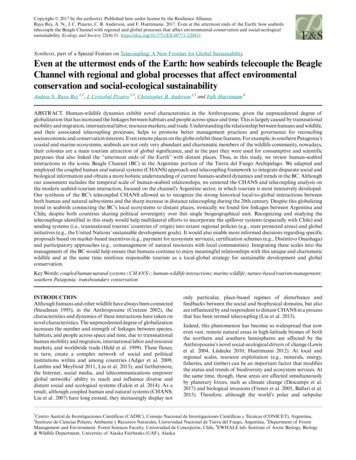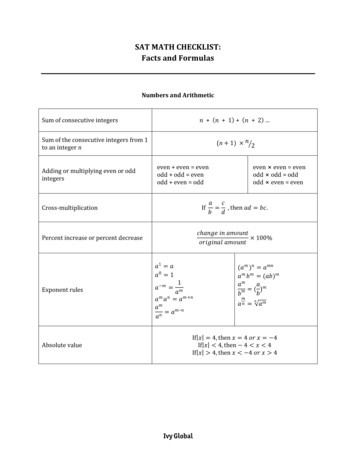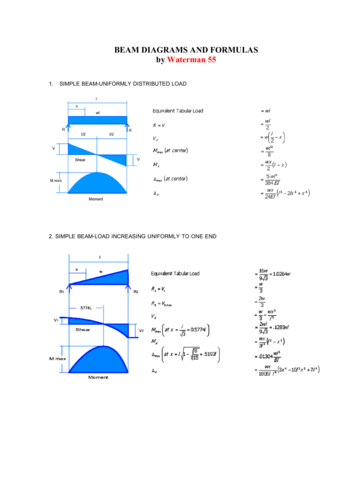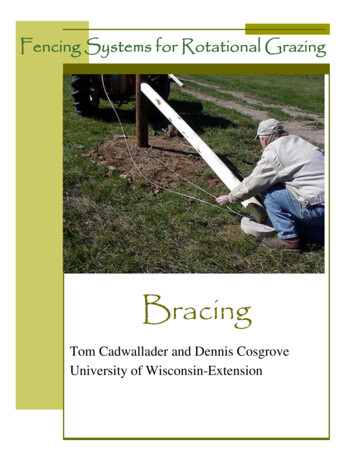
Transcription
Copyright 2017 by the author(s). Published here under license by the Resilience Alliance.Raya Rey, A. N., J. C. Pizarro, C. B. Anderson, and F. Huettmann. 2017. Even at the uttermost ends of the Earth: how seabirdstelecouple the Beagle Channel with regional and global processes that affect environmental conservation and social-ecologicalsustainability. Ecology and Society 22(4):31. https://doi.org/10.5751/ES-09771-220431Synthesis, part of a Special Feature on Telecoupling: A New Frontier for Global SustainabilityEven at the uttermost ends of the Earth: how seabirds telecouple the BeagleChannel with regional and global processes that affect environmentalconservation and social-ecological sustainabilityAndrea N. Raya Rey 1,2, J. Cristobal Pizarro 1,3, Christopher B. Anderson 1,2 and Falk Huettmann 4ABSTRACT. Human-wildlife dynamics exhibit novel characteristics in the Anthropocene, given the unprecedented degree ofglobalization that has increased the linkages between habitats and people across space and time. This is largely caused by transnationalmobility and migration, international labor, resource markets, and trade. Understanding the relationship between humans and wildlife,and their associated telecoupling processes, helps to promote better management practices and governance for reconcilingsocioeconomic and conservation interests. Even remote places on the globe exhibit these features. For example, in southern Patagonia’scoastal and marine ecosystems, seabirds are not only very abundant and charismatic members of the wildlife community, nowadays,their colonies are a main tourism attraction of global significance, and in the past they were used for consumptive and scientificpurposes that also linked the “uttermost ends of the Earth” with distant places. Thus, in this study, we review human-seabirdinteractions in the iconic Beagle Channel (BC) in the Argentine portion of the Tierra del Fuego Archipelago. We adapted andemployed the coupled human and natural systems (CHANS) approach and telecoupling framework to integrate disparate social andbiological information and obtain a more holistic understanding of current human-seabird dynamics and trends in the BC. Althoughour assessment includes the temporal scale of human-seabird relationships, we centered the CHANS and telecoupling analysis onthe modern seabird-tourism interaction, focused on the channel’s Argentine sector, in which tourism is most intensively developed.Our synthesis of the BC’s telecoupled CHANS allowed us to recognize the strong historical local-to-global interactions betweenboth human and natural subsystems and the sharp increase in distance telecoupling during the 20th century. Despite this globalizingtrend in seabirds connecting the BC’s local ecosystems to distant places, ironically we found few linkages between Argentina andChile, despite both countries sharing political sovereignty over this single biogeographical unit. Recognizing and studying thetelecouplings identified in this study would help multilateral efforts to incorporate the spillover systems (especially with Chile) andsending systems (i.e., transnational tourists’ countries of origin) into extant regional policies (e.g., state protected areas) and globalinitiatives (e.g., the United Nations’ sustainable development goals). It would also enable more informed decisions regarding specificproposals based on market-based incentives (e.g., payment for ecosystem services), certification schemes (e.g., Distintivo Onashaga)and participatory approaches (e.g., comanagement of natural resources with local communities). Integrating these scales into themanagement of the BC would help ensure that humans continue to enjoy meaningful relationships with this unique and charismaticwildlife and at the same time reinforce responsible tourism as a local-global strategy for sustainable development and globalconservation.Key Words: coupled human natural systems (CHANS); human-wildlife interactions; marine wildlife; nature-based tourism management;southern Patagonia; transboundary conservationINTRODUCTIONAlthough humans and other wildlife have always been connected(Steadman 1995), in the Anthropocene (Crutzen 2002), thecharacteristics and dynamics of these interactions have taken onnovel characteristics. The unprecedented degree of globalizationincreases the number and strength of linkages between species,habitats, and people across space and time, due to transnationalhuman mobility and migration, international labor and resourcemarkets, and worldwide trade (Held et al. 1999). These fluxes,in turn, create a complex network of social and politicalinstitutions within and among countries (Adger et al. 2009,Lambin and Meyfroid 2011, Liu et al. 2013), and furthermore,the Internet, social media, and telecommunications empowerglobal networks’ ability to reach and influence diverse anddistant social and ecological systems (Eakin et al. 2014). As aresult, although coupled human and natural systems (CHANS;Liu et al. 2007) have long existed, they increasingly display not1only particular, place-based regimes of disturbance andfeedbacks between the social and biophysical domains, but alsoare influenced by and respondent to distant CHANS in a processthat has been termed telecoupling (Liu et al. 2013).Indeed, this phenomenon has become so widespread that noweven vast, remote natural areas in high-latitude biomes of boththe northern and southern hemispheres are affected by theAnthropocene’s novel social-ecological drivers of change (Lewiset al. 2004, Lüdecke 2010, Huettmann 2012). At local andregional scales, resource exploitation (e.g., minerals, energy,fisheries, and timber) can be an important factor that modifiesthe status and trends of biodiversity and ecosystem services. Atthe same time, though, these areas are affected simultaneouslyby planetary forces, such as climate change (Descamps et al.2017) and biological invasions (Frenot et al. 2005, Ballari et al.2015). Therefore, although the world’s polar and subpolarCentro Austral de Investigaciones Científicas (CADIC), Consejo Nacional de Investigaciones Científicas y Técnicas (CONICET), Argentina,Instituto de Ciencias Polares, Ambiente y Recursos Naturales, Universidad Nacional de Tierra del Fuego, Argentina, 3Department of ForestManagement and Environment. Forest Sciences Faculty, Universidad de Concepción, Chile, 4EWHALE lab- Institute of Arctic Biology, Biology& Wildlife Department, University of Alaska Fairbanks (UAF), Alaska2
Ecology and Society 22(4): 31/biomes are often classified as pristine wilderness (sensuMittermeier et al. 2003), in fact they are not only under thepressure of sustaining local human population needs (e.g.,resources, urbanization, and economic development), but alsoface novel pressures from globalization, including being topdestinations for the international tourism industry (Lück et al.2010, Huettmann 2012, Tin 2016).Consequently, studying human-nature interactions is ever morerelevant and challenging, even in faraway places and fornonconsumptive uses like tourism. Plus, a CHANS perspectiveof these phenomena alone is insufficient because they must beunderstood vis-à-vis their relationships with other systems overlarge spatial distances (i.e., telecoupling). In this way, new researchshould be oriented to better inform natural resource managementby connecting local-to-global factors of socioeconomic andecological studies that seek to reconcile nature conservation andhuman well-being (Carter et al. 2014). In particular, thetelecoupling approach helps scholars and managers to identifyand assess a system’s (or a problem’s) components, theirinterrelationships, feedbacks, and multidirectional flows thatwould otherwise go unperceived (Liu et al. 2013, Liu 2014, Eakinet al. 2014). In this sense, a more holistic view is required thatcaptures modern global social-ecological realities. To this end, theCHANS (Walker et al. 2004) and telecoupling frameworks (Liuet al. 2013, Eakin et al. 2014) complement one another and arepowerful conceptual models to better study and managebiodiversity, ecosystems, and human well-being, especially in theface of rapid changes in their social and ecological drivers.Described to the West by Anglican missionaries as the “uttermostends of the Earth” (Bridges 1949), Tierra del Fuego (TDF) is aremote archipelago at the southern tip of the South Americancontinent. Indeed, it is the southernmost landmass outside ofAntarctica, and the sub-Antarctic forest and Patagonia steppeecoregions that cover these islands are identified as two of theworld’s last remaining wilderness areas (Mittermeier et al. 2003).Building upon this western social imaginary (Moss 2014), TDFhas come to belong to an elite group of destinations that claimthe title of “end of the world” or “southernmost destination”(Lonely Planet 2016). Nonetheless, in the last century, TDFexperienced massive social and ecological transformations, butnotwithstanding this fact, in many respects it continues to beconsidered a wild frontier whose social-ecological complexity hasnot been fully considered in research or conservation (Rozzi et al.2012).For example, the Beagle Channel (BC) is a biogeographical featurethat bisects this insular system. It flows in a west-east directionfrom the Pacific to the Atlantic oceans along the southern coastof TDF Island at about 55 S (Argentina and Chile) and thenorthern coasts of Navarino and Hoste islands (Chile). As atransoceanic shipping passage, a binational political jurisdiction,a historical and cultural landmark, and an iconic naturallandscape, the BC is clearly a CHANS with significantsingularities and challenges for its integrated study andmanagement (Rozzi et al. 2004). Examining more closely oneaspect of the BC’s biodiversity, the channel also represents animportant ecosystem for bird conservation, and its Argentineportion has been classified as an important bird area (IBA; DiGiacomo et al. 2007). However, this status does not imply anyenforceable legal protection. In turn, these birds and theirassociated marine ecosystem contribute to all four ecosystemservice categories delineated by the Millennium EcosystemAssessment (MEA 2003), including provisioning, regulating,cultural, and supporting services (Whelan et al. 2008, Burdon etal. 2017, Ferreira et al. 2017). Indeed, because of theirabundance, diversity, and charisma, seabirds in the BC have beenimportant to humans for millennia (Caviglia 2012), and today,they also constitute the main attraction for an expanding tourismindustry for both Argentina and Chile (Raya Rey and Schiavini2000, Schiavini and Raya Rey 2001, Reyes Arriagada et al. 2015,Nahuelhual et al. 2017). Nature-based tourism offers thepotential to preserve biodiversity, diversify the region’s economicbase, and ultimately help achieve sustainable development thatreconciles nature conservation and human well-being (Highamand Lück 2007, Liu et al. 2015, Tin 2016). However, there iscurrently a lack of conservation research and policies thataddress the human (e.g., tourism) and natural (e.g., seabirds)components of the BC together and their relationships withother parts of the world.We adapt and employ the CHANS and telecoupling frameworksto integrate disparate social and biological information of theBC (Fig. 1), focusing on the Argentine portion in which naturebased tourism is a major economic activity. Specifically, we seek(1) to contextualize today’s BC by describing historical changesin the human-seabird relationship from prehistoric times to the1980s; (2) to identify the major components of the modernhuman-seabird interaction by placing emphasis on the currentrelationship via nature-based tourism; and (3) to elucidatelinkages with systems beyond the BC’s physical and politicalboundaries by determining the agents, flows, causes, and effectsof these relationships. We aim for this contribution to allow notonly a better understanding of the trends, patterns, and dynamicsof this complex system, but also expect to support local andglobal sustainability by detecting otherwise unrecognizedconservation threats and opportunities that can be incorporatedand addressed in both social-ecological investigation andsustainable governance.Fig. 1. Map of the study area, showing the location of theBeagle Channel and the main cities and human settlements inboth its Argentine and Chilean portions.Coupled human and natural systems (CHANS) and thetelecoupling approach for human-wildlife interaction researchCarter et al.’s (2014) proposal was adapted to analyze thetelecouplings of the humans and seabirds found in the BC-
Ecology and Society 22(4): 31/Fig. 2. (A) An historical sequence shows how the human subsystem has changed in the Tierra del Fuego Archipelago from 10,000BP to present. (B) The underlying human-seabird relationship was described over this same time period. (C) Finally, these coupledhuman and natural systems were evaluated for their telecoupled connections over both space and time.CHANS, using visual representation (Figs. 2, 3) and tables (Table1). This allows the organization and review of information aboutthe BC’s subsystems to identify and assess their components,networks, and interactions. Socioeconomic data were obtainedfrom government and NGO reports, conference proceedings, andhistorical and social scientific publications. With this information,we tabulated and described the organizations, services, networks,local socioeconomics, and behaviors of the human subsystem.Ecological data were obtained mostly from natural science peerreviewed literature on seabirds to describe the communitystructure and function, as well as spatial distribution of thesespecies in the natural subsystem.on the Argentine portion of the channel, where tourism is mostprevalent and extensively developed and is of a greater economicinput to the human subsystem (Figs. 2 A, 3). Finally, we identifiedthe couplings and distance telecouplings that originate from thehuman-seabird interactions along the BC (Fig. 2 C). We thenclassified and described the five components of this telecoupling.Following Liu et al. (2015), we defined these CHANS subsystemsaccording to the flow of tourists. Finally, key ecological andsocioeconomic aspects, which drive the system, were determinedand these therefore should be taken into account for effectivesustainable tourism development that also ensures natureconservation.Although our evaluation seeks to broaden the understanding ofhumans (Fig. 2 A) and seabirds in the BC over time (Fig. 2 B, C),we centered the analysis on the seabird-tourism interaction as amethodological delimitation of the CHANS (Fig. 3), which wouldpermit greater understanding of extant and ongoing conservationresearch and policy efforts. For the same reason, we also focusedHistorical changes in human-seabird relationships in the BeagleChannelArcheological and ethno-historical data allowed us to trackhuman-seabird interactions as far back as the earliest humansettlement in the archipelago (Fig. 2 A, B, C). The remains of theShearwater (Puffinus sp.), Southern Giant Petrel (Macronectes
Ecology and Society 22(4): 31/Fig. 3. Illustration of modern human-seabird relationships in the Beagle Channel (BC):Tierra del Fuego, Argentina, analyzed as both human and natural subsystems withinteractions and telecouplings processes.giganteus), Magellanic Penguin (Spheniscus magellanicus), andseveral species of cormorants (Phalacrocorax spp.) have beenfound consistently in coastal archeological sites along the BC forboth terrestrial (Zangrando et al. 2014) and maritime huntergatherer groups (Orquera and Piana 1999, 2000, Tivoli 2010).These prehistoric societies on and along the BC used birds forvarious purposes, including subsistence (food), technology(knitting needles and tools), and ornamentation (necklaces),thereby illustrating ancient material and cultural relationshipswith birds going back 4000-6000 years BP (Tivoli 2010, 2013).Later ethno-historical data from the 19th century are consistentwith the archaeological record, documenting these humanseabird relationships for two ethnic groups that inhabited the area.The Yamana were nomadic, maritime hunter-gatherers, whonavigated in canoes among the islands, channels, and fjords fromthe BC to Cape Horn (Fig. 2 A). They fished, hunted, andcollected diverse marine, coastal, and terrestrial food, butdepended largely on marine mammals and seabirds, includingcollecting their eggs. The Selk’nam were terrestrial huntergatherers, who only inhabited TDF’s main island (Isla Grande)and used coastal resources occasionally to supplement theirprincipal meat source, the Guanaco (Lama guanicoe). Bothgroups produced rich cultural narratives about birds, includingseabirds like albatrosses (Diomedea sp.), cormorants, andpenguins (Gusinde 1982). For example, for the Yamana people,albatrosses were not only a source of food and materials, butadditionally were powerful symbols of community belonging andwere personified as characters in ceremonies and dances (Fioreet al. 2013). In summary, these records demonstrate that earlyhuman-seabird interactions linked the BC with other parts of thearchipelago through material and cultural pathways, which werecarried out by humans through navigation and terrestrial routes(Fig. 2 A, B, C).Beginning with Magellan’s voyage in the 16th century, southernPatagonia experienced an ever-greater connection to the rest ofthe Americas, Europe, and other parts of the world via exploitersand explorers (Fig. 2 A). Following the decimation of marinemammals in the northern hemisphere, the TDF archipelago wasvisited by whalers and sealers starting at the end of the 18thcentury. These boat-based expeditions sought largely to exploitthe meat, oil, and skins of seals and whales, but also extensivelyhunted penguin colonies for their oil, eggs, and guano, productsthat were subsequently sent far from the BC region (Fig. 2 B;Caviglia 2012). This commercial enterprise constitutes the firstlong-distance telecoupling processes strongly affecting thearchipelago, and it continued until the beginning of the 20thcentury (Caviglia 2012; Fig. 2 C). In the mid-19th century, the BCalso underwent a European colonization process in bothArgentina and Chile, which was heavily influenced by Britishexplorers and missionaries, as well as gold miners of diversenationalities, particularly from the Balkan Peninsula such asCroatia (Martinic 2009). The channel was formally “discovered”in 1832 and named by Captain Robert Fitz Roy, aboard thehomonymous British navy ship the H.M.S. Beagle (Caviglia2012). Later, the first permanent European settlement on theseshores was an Anglican mission, established in Ushuaia Bay in1870 (Fig. 2 A; Iparraguirre 2000). These early expeditions
Ecology and Society 22(4): 31/Table 1. The Beagle Channel (Tierra del Fuego, Argentina) conceived of as a coupled human and natural system (CHANS) with theidentification of system components, including economic activities and biological species, presented in order of relevance to the analyzedtelecoupling processes.System componentMajor characteristicBeagle Channel CHANS - ArgentinaHuman subsystemCommunityOrganizationsNaval base, border police, customs agency, provincial tourism ministry, local association of tourism guides,travel agencies and tourism operators, yacht club, urban coastal reserve association, regional research center(CADIC), national parks administration, Onashaga Commitment committee.Customs facilities, port facilities, international/Antarctica cruise ships, hotels, local boat-based wildlife tours,yachts, trails.National and provincial government administrations, Ushuaia tourism board.Local tourism businesses, tourism-related services (e.g., transportation, lodging, gastronomy, etc.), historicalcultural sites and museums.For Ushuaia: tourism, electronics factories, public sector, commerce.For the BC: tourism, maritime transportation for commerce, fisheries (crabs) and aquaculture (musselsfarming).Local-born residents (Fueguians), non-Fueguian Argentines, ranchers, local and foreign yacht owners livingin Ushuaia.Tourism, infrastructure construction and development, sector involved in conservation plans, recreationalactivities (kayaking, sailing, scuba SocioeconomicsDemographyBehaviorsNatural subsystemLand coverSpatial distributionCompositionStructureWildlifeSalient gMarine channel connecting the Atlantic and Pacific oceans interspersed with numerous islands (n 32),bands of kelp forests (Macrocystis pyrifera) border shorelines in subtidal zones.Islands vary from rocky outcrops to vegetated with herbaceous and woody plants, inter-tidal zone, subtidalzone dominated by kelp forests.Bathymetry defines shallow areas where kelp beds are common. The water depths are variable, increasingfrom the east to the west, reaching depths greater than 150 m in the center of the channel. Surface salinity isstrongly affected by fresh water courses (runoff and glacial melting), being higher close to the mouth of thechannel because of the influence of the Atlantic Ocean and decreasing toward the west or the inner part ofthe channel due to the presence of glaciers. The exposure to wave and to the westerly prevailing winds changesbecause of the orientation of the coast. Thus, generally the windward coasts show a slope more pronouncedthan leeward coasts. Human infrastructure is important in this region. Ushuaia and Puerto Williams, twourban centres situated along the coast of the Beagle Channel, have increased feeding opportunities foropportunist birds, such as gulls and petrels, which feed on garbage.Marine mammals include pinnipeds like the South American sea lion (Otaria flavescens), South American furseal (Arcthocephalus australis), and leopard seal (Hydrurga leptonyx); cetaceans include whales like thehumpback (Megaptera novaeangliae), sei (Balaenoptera borealis), and minke (B. acutorostrata). Dolphinsinclude Peale’s (Lagenorhynchus australis and dusky (L. obscurus); and Burmeister’s porpoises (Phocoenaspinipinnis).Migratory to partially-migratory seabirds include Black-browed Albatross (Thalassarche melanophris),Southern Fulmar (Fulmarus glacialoides), diving petrels (Pelecanoides spp.), Magellanic Penguin (Spheniscusmagellanicus), Chilean Skua (Stercorarius chilensis), and South American Tern (Sterna hirundinacea).Resident seabird species include Southern Giant Petrel (Macronectes giganteus), Magellanic Cormorant(Phalacrocorax magellanicus), Imperial Cormorant (P. atriceps), Kelp and Dolphin Gulls (Larus dominicanus,Leucophaeus scoresbii).Terrestrial and coastal bird species include Patagonia’s endemic Blackish Cinclodes (Cinclodes antarcticus),Kelp Goose (Chloephaga hybrida), and Flightless Steamer Duck (Tachyeres pteneres).Long-distance migratory shorebirds like the Baird’s (Calidris bairdii) and White-rumped (C. fuscicollis)Sandpipers.Some species populations are stable (e.g., Imperial Cormorants), some declining (e.g, Rock Cormorants), andseveral present unknown trends (e.g., South American Terns). Cormorants show movements between islandswithin the BC, and South American Terns avoid islands with nearby human inhabitation or visits.Seabirds and mammals feed along the channel. Seabirds, like cormorants and gulls, as well as waterfowl andcoastal birds breed in the islands. Sea lions are clustered in colonies over the small islets.Seabird colonies are visited frequently by tourist boats. Whales are occasionally followed by tourist boats.Tourism, both local and foreign tourists, through the local Ushuaia activity of excursions onboard vesselsalong the BC, connecting with other places where tourists go before and after. Usually tourists visitingUshuaia do this as a part of a Patagonian trip, which includes other places in Argentina and also Chile, orthey visit the region as part of a cruise trip.brought influential naturalists, most notably Charles Darwin,into contact with the BC and initiated an era not only ofcolonization, but also of wildlife study and specimen collectionand description, which introduced a new human-seabirdrelationship to this territory (Fig. 2 B). Consequently, the BCbecame teleconnected with the British Empire and other worldcapitals not only via exploration, immigration, and colonization,but also by way of nascent scientific disciplines that wouldeventually arise out of natural history (Fig. 2 C; Darwin 1909).During this period, TDF and the BC in effect were unclaimedgeopolitical territories by both Argentina and Chile. Ushuaia was
Ecology and Society 22(4): 31/officially founded as the capital of the Argentine portion of TDFin 1884 with the establishment of a naval base (van Aert 2013).The town’s demographic expansion was slow and based largelyon immigrants from Europe, Chile, and other Argentineprovinces, who worked for the federal penitentiary built by thenational government or in small-scale ranching activities.Human-seabird interactions for this population (e.g., prisoners,miners, ranchers) are poorly documented. It is possible todetermine, though, that the BC’s human subsystem changed itscultural and ethnic composition, but the national boundaries stillwere largely theoretical and did not hinder cross-borderconnectivity and movement of people and commerce between theArgentine and Chilean portions of the channel (Bridges 1949).In the 1970s, however, tensions arose between the two nationsover the sovereignty of three small islands at the mouth of theBC: Picton, Nueva, and Lennox. War was only barely averted,and in 1984 a peace treaty was mediated by the Pope. This episodeprecipitated a new CHANS condition in the BC by effectivelydisconnecting the socioeconomic, political, and culturalrelationships between the two sides of the channel. Atapproximately the same time, the Argentine territory was affectedby a new law for industrial promotion (#19,640), which createdfinancial incentives for the settlement of companies and residentson the island, causing Ushuaia to become a boom town. Itspopulation rose from 313 (indigenous population excluded) in1895 to 5000 in 1970, but then expanded exponentially to 60,000by 2010 (van Aert 2013). Consequently, the human subsystem inthe Argentine portion of the BC came to be characterized by rapidgrowth, expansion of commercial port facilities, and ensuingproblems with infrastructure, given the inability to meet theincreasing demands of this new population influx and itsconsequences for the environment (i.e., drinking water provision,sewage treatment, urban deforestation; Braumann and Stadel1999).Simultaneous with the financial incentives that increased theisland’s human population and industrialization, sub-Antarctic/Antarctic tourism also began to emerge in the late 1970s (Fig. 2A). At the same time, the Argentine government’s NationalCouncil for Scientific and Technical Research (CONICET)established the Austral Center of Scientific Research (CADIC),which inaugurated a more formal and permanent era of scientificinvestigation (and scientific telecouplings) not only for the BC,but also with Antarctica (Fig. 2 C). Together, science and naturebased tourism established a new human-seabird relationship witha new set of actors and interactions that telecoupled the BC toregional and global scales (Fig. 2 B, C; Rabassa and Borla 2003).Cruise ships started to operate from Ushuaia, with boats fromdistant places and foreign owners transporting people from allaround the world and connecting TDF with the whole continentand other distant countries (Herbert 2014). This economicactivity has grown quickly and was accompanied by newinfrastructure, such as an expanded airport and maritime port.Tourism in the BC also increased exponentially during this period(Raya Rey et al. 2014). Today, tourism is a principle componentof the BC’s human subsystem and is focused largely on the naturalscenery and wildlife at the end of the world (Figs. 2 C, 3). Thiseconomic activity has integrated natural-science research aboutseabirds, but also includes ancestral and historical narrativesabout human-nature interactions and relationships in differenttime periods. As such, the tourism-seabird relationshipincorporates both historical and modern coupling betweenhuman and natural subsystems.Identification of key elements of the Beagle Channel as a coupledhuman and natural system (CHANS)Natural subsystemThe BC’s many islands and smaller islets are home to variousseabird species, particularly colony-forming species like theImperial (Pahalocrocorax atriceps) and Rock Cormorants (P.magellanicus), Gentoo (Pygoscelis papua) and MagellanicPenguins, and the Kelp Gull (Larus dominicanus; Raya Rey et al.2014; Table 1). In particular, seabirds are key components of theBC’s marine and coastal ecosystems, given their high biomass(Pizarro et al. 2012) and their large effects on trophic relationshipsin these waters (Raya Rey and Schiavini 2000). Researchconducted during the last 20 years by CADIC has shown thatpopulation trends vary between species and within and betweenyears. For example, although Rock Cormorant numbers aredeclining, Magellanic Penguin populations are increasing (RayaRey et al. 2014). Plus, several waterfowl species, such as the KelpGoose (Chloephaga hybrida), have become more restricted tosmall islands and islets in the channel to avoid native andintroduced terrestrial predators and other human disturbancesthat have become greater in the Argentine portion of the BC(Liljesthröm et al. 2013).The seabird community found in and along the BC also displaysregional and global connections. For example, the cha
(Lonely Planet 2016). Nonetheless, in the last century, TDF experienced massive social and ecological transformations, but notwithstanding this fact, in many respects it continues to be considered a wild frontier whose social-ecological complexity has not been fully co










